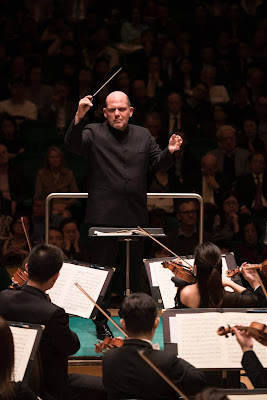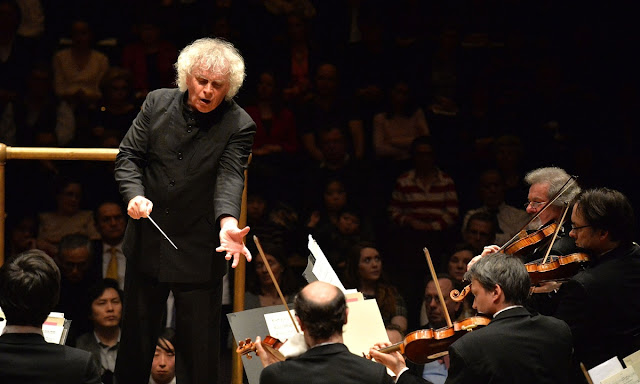Soprano - Zhou Yuqian
Mezzo Soprano - Deborah Humble
Tenor - Charles Reid
Bass - Kwangchul Youn
The Chorus of the National Centre for the Performing Arts, BeijingMezzo Soprano - Deborah Humble
Tenor - Charles Reid
Bass - Kwangchul Youn
Hong Kong Philharmonic Orchestra
Conductor - Jaap van Zweden
The Hong Kong cycle of the Beethoven Symphonies in the past month was another landmark development of the Philharmonic Orchestra. The strings sections had improved in tone colour and body of sound since Jaap van Zweden took over the directorship since 2012. Though tiredness sunk in as the week progressed and the musicians' stamina were tested. The wind sections did not always maintain the same consistency and responsiveness in playing as the strings which resulted in some untidy corners. The phrasing of music was good generally and in style to the textures of each symphony. I was relieved that Zweden did not repeat the heavy handed execution of Mozart's Symphony No. 40 few months ago with controlled conducting style and employed overpowering dynamics. He knew the road map mostly well enough of navigating the band through the marathon. His conducting style certainly worked better with certain symphonies but not a solution for all.
The cycle first began with the eighth symphony followed by the third, which supposedly to mark the contrasting themes during the composer's midlife creative period. The orchestral playing in the eighth delivered the warmth and a lively pastoral image with an Italianate flair. The strength of Zweden's conducting was that he allowed the space for the music to sing and breath, but never drag and maintained the level of momentum with a rather brisk tempo. It was a satisfying start, but later using the same approach on the third symphony, I felt it ignored the underlying ideology. The playing was polished and fine but made no contrast made in the produced tone and tempo spacing. One wondered where was the image of Prometheus, the mystical hero expressed as resistance to tyranny, when the funeral match sounded ever so positive without the feeling of lament or suffering. A monumental creation of a hero with great sentiments was not necessary but the outlook and philosophy should not be in absence. Neither the conductor nor the orchestra seems to grasp the thinking but only to structure the work just like the rest they came across.
The same problem continued with the Pastoral symphony in the following week, which the drawing board for programmed symphonies happened to be the weak point for the conductor and the orchestra. The playing was neat but it lacked a direction. The absence of momentum resulted in sluggish dialogues between sections and as a whole failed to craft the structure, despite some beautiful passages from the flautist. When the heart was not in place, one could hear the produced tone colour from the strings sounded bland and dull. It was not disastrous but created a misconception among the audience that the symphony failed to make a strong impression as the seventh during interval. Neither should both works be compared easily since the Pastoral symphony stood on its own to emphasise the rare tranquillity and calm mental state of the composer, instead of the tempest and thunderstorm came under the conflictive inner emotions.
By contrast, the seventh symphony in the second half was a success and brilliant as always. The orchestra was at home here. Varied tone colours, energy, phrasing and musical direction were all in display. It created the sense of drama and excitement that marked the characters of this symphony. After the confident and highly spirited first movement, the band gradually built up the pace from the solemn match in the second movement before reaching the climatic exultation in the last movement, which one felt the composer wholeheartedly thrilled about. Zweden's conducting also transformed that he knew where to indicate the orchestra and achieved the desired effects. The only minor problem was the trumpets occasionally under the pitch and I wondered whether it was necessary to use the German rotary ones than the usual B flat type.
The next instalment brought the second, fourth and fifth symphonies together. Besides being a stamina test to play three works in the same evening, more importantly, the compositional progression that Beethoven linked his suffering from deafness with inner emotional struggles. Both the second and fourth had a mysterious sombre like introduction before the return of optimism. Not so much in the style of some late Haydn's symphonies, but signs of the composer's depression battled against the effects of hearing impairment were there. By the last movement of the fourth symphony, showers of semiquavers at break neck tempo seems to suggest the composer not in the best of psychological state. After years listening to various performances of the fifth symphony, it was the first time I felt the work was not a natural triumphant for the composer to overcome the problem of hearing loss, but instead a forceful personal statement to hold the vulnerable mind together with a desperate optimism. On the other hand, the composer eventually found his 'voice' in the symphonies from the struggles and sufferings.
On the performance side it was the evening that the Philharmonic Orchestra managed to maintain the same consistency throughout their playing despite the physical challenge, and Zweden knew the three works well enough to provide a clear guide with his conducting. The woodwind section was also at their best form in this cycle with many fine playings and the presence of an intimate musical dialogues that not often the case. It was not surprised that the first violins gradually showing signs of tiredness with one or two tutti moments being fractions behind from the rest. Otherwise, musically it was an inspiring evening and the tale centred around the composer being vividly realised.
The final instalment was on purpose a contrast between the early and late periods of the composer's compositional style, but both the first and the ninth symphonies were also revolutionary in musical form and language. The first was not so much different in characters from the eighth. The Italianate warmth and pastoral image at harvest time summed up a happier time for Beethoven at his youthful years. The traditional first movement structure was placed in the last movement instead whereas the bold passionate opening movement echoing the styles of Mozart's late symphonies. Just like the eighth, the musical texture and tone colours worked very well to the core produced sound of the orchestra. The playing was never aggressive or overpowering and retained the sense of elegance and beauty that fitted perfectly into the pastoral scene. The band seems natural of its musical dialogues and Zweden was visibly pleased with the result at the end of first half.
The ninth symphony often only remembered by rousing choral passages in the last movement but what made it differed from other symphonies were the harmonic texture and structural progression. The first movement no longer in the shadow of classical period that major and minor keys interwoven together. Scherzo formed the second movement followed by an expressive and tranquil Adagio in the third movement. The tempo Zweden took in the first two movements were rather robust and swift. He pushed the orchestra to produce the momentum alike mounting on a chariot, and there were corners I felt the orchestral playing being unsettled and even sounded angry. Despite a rich body of sound resulted from the darker tone on the strings, the playing of the first violins made a raw sound that lost some of the silkiness it produced before. The NCPA chorus was fine in vocal volume and intonation, but mostly only vowels could be heard and difficult to make sense of their diction. The soprano soloist Zhou Yuqian was a last minute replacement and just about to match her colleagues in the quartet. I would still prefer to hear Deborah Humble and Kwangchul Youn singing other pieces in slower tempo than the machine gun like vocal sections of this symphony. Zweden's energetic conducting also caused some uncertain entries that the soloists were not together with the orchestra. Here the stirring coda felt to be an earthy celebration of ideology Beethoven believed in since Eroica Symphony but not quite the culmination marking the groundbreaking expression of the musical form.
Overall, I felt very inspired by this Beethoven cycle and the orchestra should congratulate themselves how much it had progressed all this years to achieve the current standard. Though more works need to be done on the brass and woodwinds to match the quality and consistency among the strings if it aims to improve further.
















































